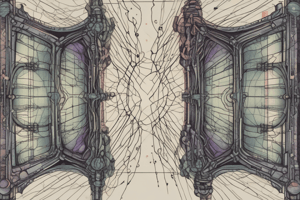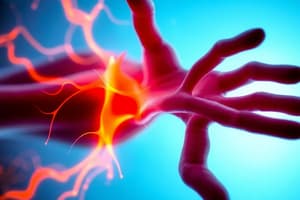Podcast
Questions and Answers
What is the primary function of the inhibitory pathway in pain processing?
What is the primary function of the inhibitory pathway in pain processing?
- To suppress pain through response and neurotransmitters (correct)
- To interpret pain intensity and location
- To enhance pain perception
- To transmit pain signals to the brain
What type of pain is characterized by well-localized, sharp pain with obvious tissue injury?
What type of pain is characterized by well-localized, sharp pain with obvious tissue injury?
- Allodynia
- Nociceptive pain (correct)
- Hyperalgesia
- Neuropathic pain
Which type of fibers are responsible for transmitting sharp pain signals?
Which type of fibers are responsible for transmitting sharp pain signals?
- Sensory fibers
- C fibers
- Motor fibers
- Aδ fibers (correct)
What is the term for decreased sensitivity to painful stimuli?
What is the term for decreased sensitivity to painful stimuli?
Which structure is involved in the modulation of pain processing?
Which structure is involved in the modulation of pain processing?
What is the origin of the word 'pain'?
What is the origin of the word 'pain'?
What is the goal of pain, according to the lecture?
What is the goal of pain, according to the lecture?
Which of the following is NOT a component of pain?
Which of the following is NOT a component of pain?
According to the gate control theory, which fibers bring pain signals?
According to the gate control theory, which fibers bring pain signals?
What is the relationship between pain, anxiety, and depression, according to the lecture?
What is the relationship between pain, anxiety, and depression, according to the lecture?
Flashcards are hidden until you start studying
Study Notes
Origin of Pain
- The word "pain" comes from the Latin "poena," meaning "punishment."
- The word "patient" comes from the Latin "patior," meaning "to endure punishment/pain."
- Pain was initially viewed as a curse, but it's actually a gift that helps people avoid unpleasant experiences and learn from them.
Definition of Pain
- Pain is a sensory and emotional experience caused by actual or threatened tissue damage.
- It's associated with personal physical, functional, psychological, or emotional factors.
- Pain is considered a 5th vital sign.
Components of Pain
- Detection: recognizing pain stimuli
- Qualitative definition: describing the type of pain
- Location: identifying where the pain is located
- Intensity: measuring the severity of pain
Pain Theories
- Injury activates receptors, and the absence of a cause is considered a psychological illness.
- Gate control theory: Aα and Aβ fibers do not transmit pain signals, while Aδ and C fibers do.
- Central pain matrix theory: the brain processes pain through structures like the somatosensory cortex, ACC, limbic system, and insula.
Pain Triangulation
- Pain is linked to anxiety and depression, and addressing one can affect the others.
- As a doctor, it's essential to consider multiple aspects of a patient's care.
Physiology of Pain
- Nociception: the detection system for internal and external stimuli that threaten the body.
- Nociceptive pain is a result of excessive stimulation, and nociceptors only activate in response to noxious stimuli.
- Pain can be acute, chronic, visceral, somatic, or inflammatory.
Pain Perception
- The sense of pain is brought by lateral pathways, involving the somatosensory center and anterior cingulate cortex.
- The feeling of suffering is brought by medial pathways, involving the limbic system, anterior insula, and cognitive, emotional, and autonomic processes.
- Pain can exist without suffering, and suffering can exist without pain.
Testing of Pain Perception
- Pain perception is tested using sharp pins to elicit a pain sensation.
- Oversensitivity is hyperalgesia, while the opposite is hypoalgesia.
- Hypoalgesia or analgesia is often seen on the periphery of a site with allodynia.
Pain Processing
- Transduction: injury activates free nerve endings, leading to inflammation and the release of various chemicals.
- Transmission: Aδ and C fibers transmit sharp and dull pain, respectively.
- Modulation: pain inhibition occurs through opioids, and interpretation involves identifying the location and intensity of pain and associating it with personal experiences.
Classifications of Pain
- Based on type: nociceptive (physiologic pain) and neuropathic (pathological pain).
- Based on duration: acute and chronic pain.
Studying That Suits You
Use AI to generate personalized quizzes and flashcards to suit your learning preferences.




